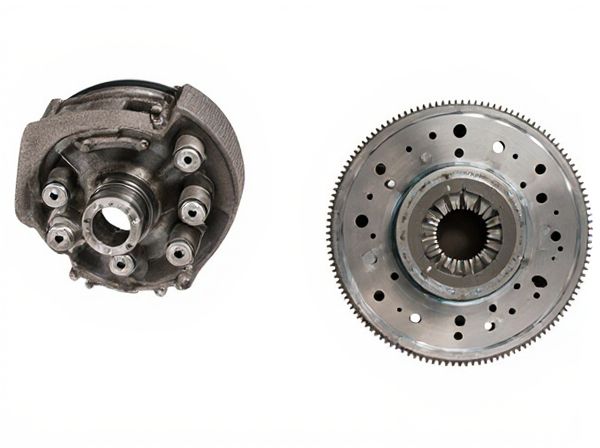
Photo illustration: Open Differential vs Limited Slip Differential
An open differential allows the wheels to rotate at different speeds, providing smooth turns but may struggle with traction on slippery surfaces since power is sent to the wheel with the least grip. A limited slip differential improves traction by distributing torque more effectively between wheels during acceleration or cornering, reducing wheel spin in low-traction conditions. Understanding the differences can help you choose the right differential for improved vehicle performance and stability.
Table of Comparison
| Feature | Open Differential | Limited Slip Differential (LSD) |
|---|---|---|
| Function | Allows wheels to rotate at different speeds for smooth cornering | Limits wheel spin by distributing torque to the wheel with more grip |
| Traction | Lower traction on slippery or uneven surfaces | Improved traction on slippery or uneven surfaces |
| Cost | Less expensive, common in most standard vehicles | Higher cost due to complex design and components |
| Maintenance | Low maintenance requirements | Requires regular checks and maintenance for optimal performance |
| Performance | Suitable for everyday driving and mild conditions | Enhanced performance for sports driving, off-road, and high torque applications |
| Complexity | Simple mechanical design | More complex with clutches or gears to limit slip |
Introduction to Differentials
Differentials are mechanical devices that distribute engine torque to the wheels, allowing them to rotate at different speeds, especially during cornering. An open differential provides equal torque to both wheels but can cause wheel slip on low-traction surfaces. Limited slip differentials enhance traction by automatically redirecting torque to the wheel with the most grip, improving vehicle stability and performance.
What is an Open Differential?
An open differential is a type of automotive differential that allows wheels on the same axle to rotate at different speeds, essential for smooth cornering. It distributes engine torque equally to both wheels but can cause one wheel to lose traction if it spins freely, limiting overall performance on slippery surfaces. Open differentials are common in standard vehicles due to their simplicity and cost-effectiveness but lack the enhanced traction capabilities of limited slip differentials (LSD).
How an Open Differential Works
An open differential allows the wheels to rotate at different speeds, especially during turns, by distributing torque evenly to both wheels. It uses a set of spider gears that enable one wheel to spin faster or slower than the other, improving traction on smooth surfaces. However, it struggles with traction on slippery or uneven terrain because torque is sent to the wheel with the least resistance.
What is a Limited Slip Differential?
A Limited Slip Differential (LSD) enhances vehicle traction by distributing torque between wheels, preventing one wheel from spinning freely when traction is lost. Unlike an Open Differential that allows wheels to rotate independently at varying speeds, the LSD uses clutch packs or gears to limit speed differences, improving stability and control during acceleration or cornering. This mechanism is essential in performance cars and off-road vehicles for maintaining grip on slippery or uneven surfaces.
How a Limited Slip Differential Functions
A Limited Slip Differential (LSD) functions by distributing torque to the wheel with the most traction, preventing excessive wheel spin in slippery conditions. It uses clutch packs, gears, or a viscous coupling to limit the speed difference between the two wheels on an axle, enhancing vehicle stability and cornering performance. Compared to an Open Differential that allows wheels to rotate at different speeds without torque restriction, the LSD provides improved power delivery and control in challenging driving scenarios.
Key Differences: Open vs Limited Slip Differential
Open differentials allow each wheel to rotate independently, providing smooth turns but limited traction on slippery surfaces. Limited slip differentials distribute torque to both wheels, improving traction and handling, especially in challenging conditions like off-road or wet roads. The key difference lies in torque distribution: open differentials send power to the wheel with the least resistance, while limited slip differentials actively manage power delivery to prevent wheel spin.
Advantages of Open Differentials
Open differentials offer superior maneuverability by allowing each wheel to rotate at different speeds, which is crucial when turning corners. They provide smoother handling on paved roads and reduce tire wear due to balanced power distribution. Open differentials are also simpler and more cost-effective to manufacture and maintain compared to limited slip differentials.
Benefits of Limited Slip Differentials
Limited Slip Differentials (LSD) provide enhanced traction by distributing torque more effectively between wheels, improving vehicle stability and performance in challenging driving conditions such as off-road, wet, or icy surfaces. LSDs reduce wheel slip during acceleration and cornering by limiting the speed difference between wheels, resulting in better control and reduced tire wear compared to Open Differentials. This advanced torque management enhances safety and handling precision, especially in performance and all-wheel-drive vehicles.
Applications and Use Cases
Open differentials are commonly used in everyday passenger vehicles due to their simplicity and cost-effectiveness, providing ideal performance on dry, paved roads where traction is consistent. Limited slip differentials (LSDs) are preferred in performance cars, off-road vehicles, and race cars because they enhance traction by distributing torque to the wheel with more grip, improving handling and stability on slippery or uneven surfaces. Off-road enthusiasts and motorsport professionals rely on LSDs to maintain control in challenging terrains such as mud, snow, and sharp turns where open differentials would cause wheel spin and power loss.
Choosing the Right Differential for Your Vehicle
Choosing the right differential for your vehicle depends largely on your driving conditions and performance needs; an open differential offers smooth handling on paved roads by allowing wheels to rotate at different speeds, enhancing fuel efficiency and tire longevity. Limited slip differentials provide better traction on slippery or off-road surfaces by distributing torque to the wheel with the most grip, crucial for performance cars, trucks, and SUVs tackling uneven terrain. Prioritize driving environment and vehicle purpose when selecting between open and limited slip differentials to optimize stability, control, and overall driving experience.
 caratoz.com
caratoz.com